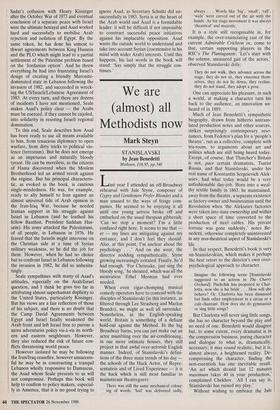We are (almost) all Methodists now
Mark Steyn
STANISLAVSKI by Jean Benedetti Methuen, £16.95, pp.340 ast year I attended an off-Broadway rehearsal with Jule Styne, composer of Gypsy and Gentlemen Prefer Blondes and a man unused to the ways of fringe com- panies. He seemed to be enjoying it all until one young actress broke off and embarked on the usual thespian gibberish: `Can we stop a moment? I'm a little confused right here. it seems to me that — er — my lines are mitigating against my entrance, and I don't feel they should. Also, at this point, I'm unclear about the psychology . .' And on she went, the director nodding sympathetically, Styne growing increasingly irritated. Finally, he'd had enough, 'For Chrissake, just sing the bloody song,' he shouted, which was all the motivation Ethel Merman had ever needed.
When even cigar-chomping musical comedy operators have to contend with the disciples of Stanislayski (in this instance, as filtered through Lee Strasberg and Marlon Brando), we might as well all surrender. Nonetheless, in the English-speaking world, Britain is something of a defiant hold-out against the Method. In the big Broadway barns, you can just make out an actor mumbling over the air-conditioning; in our more intimate houses, they still project in that awful over-actorish English manner. Indeed, of Stanislayski's defini- tions of the three main trends of his day the schools of the Hack Actor, of Repre- sentation and of Lived Experience — it is the hack which is still most familiar to mainstream theatregoers:
There was still the same mechanical colour- ing of words: 'Sad' was delivered sadly, always . . Words like 'big', `small', 'tall', `wide' were carved out of the air with the hands. As for stage movement it was always `theatrical' and majestic.
It is a style still recognisable in, for example, the over-enunciating cast of the current Admirable Crichton or, come to that, certain supporting players in the RSC's The Plantaganets: 'Let's start with the solemn, measured gait of the actors,' observed Stanislayski drily:
They do not walk, they advance across the stage, they do not sit, they ensconce them- selves, they do not lie down, they recline, they do not stand, they adopt a pose,
One can appreciate his pleasure, in such a world, at making a character turn his back to the audience, an innovation un- heard of in 1889.
Much of Jean Benedetti's sympathetic biography, drawn from hitherto untrans- lated production notes and other sources, strikes surprisingly contemporary reso- nances, from Fedotov's plan for a 'people's theatre', run as a collective, complete with tea-room, to arguments about art and politics which are still being heard today. Except,. of course, that Thatcher's Britain is not, pace certain dramatists, Tsarist Russia, and that Stanislayski, under his real name of Konstantin Sergeievich Alek- seiev, had what today would be a very unfashionable day-job. Born into a weal- thy textile family in 1863, he maintained, away from the theatre, a separate existence as factory-owner and businessman until the Revolution when 'the Alekseiev factories were taken into state ownership and within a short space of time converted to the production of steel cables. His private fortune was gone suddenly,' notes Be- nedetti, otherwise completely uninterested in any non-theatrical aspect of Stanislayski's life.
In that respect, Benedetti's book is very un-Stanislayskian, which makes it perhaps the best retort to the director's own over- psychological approach to character.
Imagine the following scene [Stanislayski suggested to an actress in The Cherry Orchard]: Pischchik has proposed to Char- lona, now she is his bride . . . How will she behave? Or: Charlotta has been dismissed but finds other employment in a circus or a cafe-chantant. How does she do gymnastics or sing little songs?
But Charlotta will never sing little songs, she has no character beyond the play and no need of one. Benedetti would disagree but, to some extent, every dramatist is in the compression business, paring character and dialogue to what is, dramatically, necessary; it may sound realistic, but it is, almost always, a heightened reality. De- compressing the character, finding the non-essentials has one inevitable result. `An act which should last 12 minutes maximum takes 40 in your production,' complained Chekhov. 'All I can say is, Stanislayski has ruined my play.' Without wishing to embrace the Jule Styne line wholeheartedly, I can't help feeling it is not the elaborate system itself which Stanislayski bequeathed to his fellow actors but merely a general licence to indulge themselves. According to Benedet- ti, the first reading at the Moscow Arts Theatre of The Three Sisters did not pass off without incident. In the discussion which followed, Chekhov heard his play qualified as a drama or a tragedy, while he insisted it was a comedy. This could be sorted out. When, however, one of the more pretentious members of the company began a pseudo-philosophical debate he quietly slipped away. Stanislayski went round im- mediately to his flat, where he found him in an angry mood but managed to calm him down.
Chekhov had much to be angry about in his relationship with Stanislayski. The stag- ing concept for Uncle Vanya involved having the cast mask their faces with handkerchiefs to protect them from the mosquitoes they were continually swatting, one of those Stanislayskian details that threatened to bury the play. 'Listen,' said Chekhov, exasperated by Stanislayski's Production values, 'I shall write a new play which will open like this: 'How wonderful, how quiet! Not a bird, a dog, a cuckoo, an owl, a nightingale, or clocks, or jingling bells, not even one cricket to be heard.'
Stanislayski in later years abandoned his obsession with strict authenticity (although not so much that he'd have been happy with Benedetti's infelicitous anachronisms: `the theatre would in every way be state-of- the-art'), but his new theories could un- balance a text just as easily. It is not a subject on which Benedetti has much to say, yet gradually, through the director's relationships first with Chekhov and then with his partner Nemirovich-Danchenko, the tension between play and production emerges as the most interesting question in the book.
For Nemirovich the basis of a production lay in a detailed literary analysis which was then, as it were, 'illustrated' by the staging; for Stanislayski, a production was created in the actual rehearsal period itself, through the active collaboration of actor, director and designer.
For me, the answer lies somewhere in the middle, although precisely where is something that has to be thrashed out with each new production. But it has to be said that Stanislayski and his methods seem fundamentally unsuited to new plays. And, ultimately, it is great plays — more than great actors or great productions — which are the lifeblood of theatre. For that reason, I was relieved when his name evoked only vague recognition in a drama student of my acquaintance. `Stanislayski?' she said. `Ah, yes. He was a friend of Chekhov.'
Mark Steyn is the Musical Theatre corres- pondent of the Independent.











































































 Previous page
Previous page